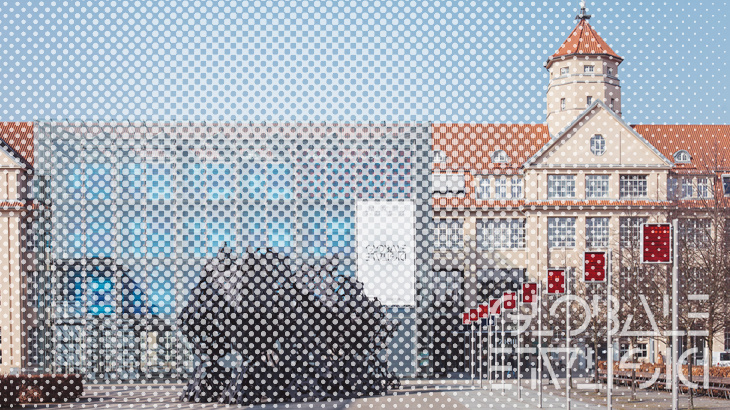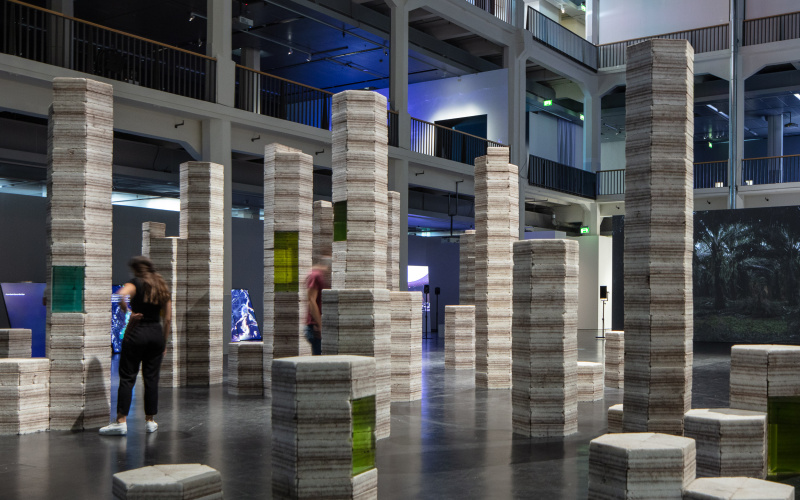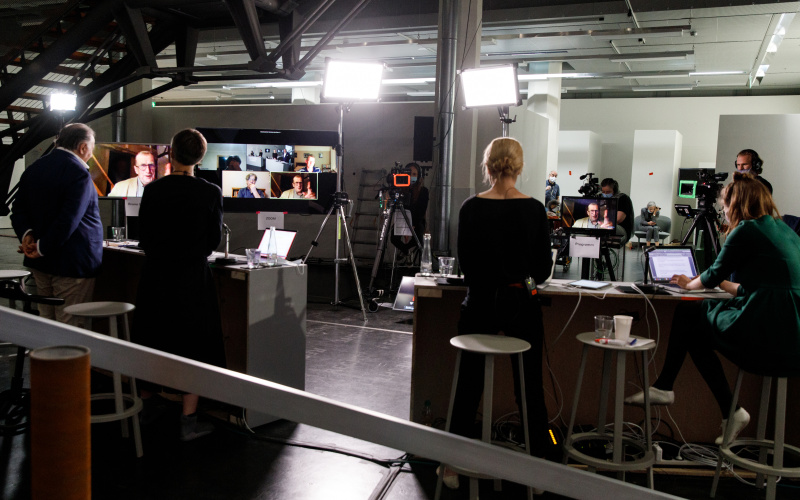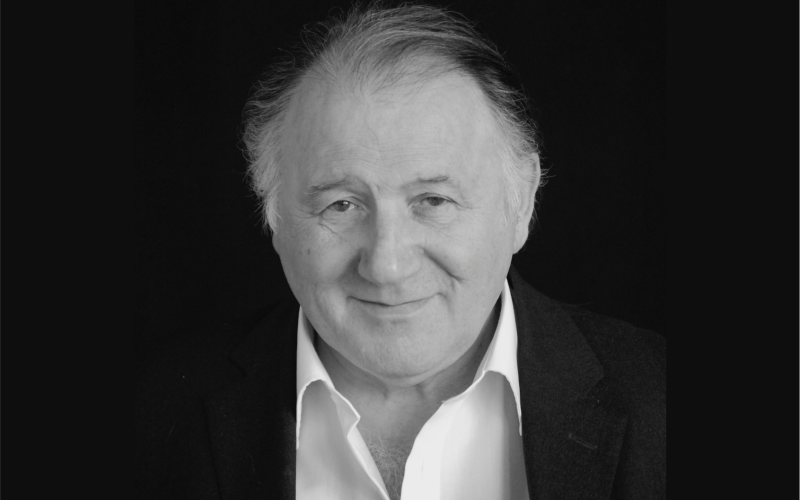KARLSRUHE – A HIDDEN CHAMPION?
In the December 2014 edition of the »The New Yorker« George Packer expressed his surprise about »The Quiet German« in Berlin. By comparison, one wonders why Karlsruhe of all places – a German city in Baden-Württemberg the very name of which includes the German word for »calm« (»Ruhe«) – so often manages to cause such a stir.
What were the conditions that made it possible for Karlsruhe – which is not located in the center of the German Republic – to develop into a »republic of scholars«? And why do people from all over the world come here to study at the KIT (The Karlsruhe Institute of Technology), the Academy of Arts, the University of Music, or the University of Arts and Design – and relocate from Berlin, Hamburg, and Munich to found their start-up companies in the Alter Schlachthof creativity park? The State of Baden-Württemberg is well known for its unknown world-market leaders, companies referred to as »hidden champions« (H. Simon, 1990). Does Karlsruhe itself qualify as such a »hidden champion«?
The emergence of Karlsruhe as a modern city is indebted, above all, to the great minds that live and have lived within its walls, and to the democratic and liberal ethos which has characterized its history from the outset. This ethos has its roots in the affinity for culture demonstrated by Karlsruhe’s rulers, especially the Margravine Karoline Luise (1723–1783), as well as the general open and forward-looking attitude typical of Karlsruhe’s citizens in the 1880s.
A Model City for Civic Rights, the Arts, and the Sciences
Thanks to the extensive liberties and advantages guaranteed ever since the city’s foundation by the charter of privileges decreed by Margrave Karl Wilhelm von Baden-Durlach in September 24, 1715, many people were attracted to settle in Karlsruhe and set up businesses. This liberal spirit of equality and justice continues to pervade the city to the present day.
Karlsruhe became an important legislative center in 1818, with the signing of Karl Friedrich Nebenius’ progressive Baden Constitution; this resulted in the erection of Germany’s first independent parliament building in 1822. The Ständehaus parliament was the focus of national attention on a number of occasions because of its milestones in German legal history. One such occasion was the »pre-March« era (pre-1848 Revolution), when impassioned calls for greater political participation, freedom of the press, public and oral judicial proceedings, and the idea of equal civil rights went out from the Parliament. Karlsruhe thus acquired the reputation of being a model city for freedom; Germany’s first Republic was proclaimed there briefly in the course of the 1848/1849 Revolutions. Today, Karlsruhe is well-known as a center of law because Germany’s most important legal institutions, such as the Federal Constitutional Court, the Federal Prosecutor’s Office, and the Federal Supreme Court are all located there.
Karlsruhe, sometimes referred to as »fan city« because of its fan-shaped groundplan, is a unique center for painters, sculptors, musicians, authors, theorists, architects, scholars, and scientists. Major figures in the intellectual history of Germany were born in Karlsruhe or lived there for many years, including the important poet and possibly the most important German art theoretician Carl Einstein, and Henry-Daniel Kahnweiler – in his youth, this early champion of the Cubists worked at the same Karlsruhe bank as Carl Einstein.
Founded in Karlsruhe in 1854, the State Academy of Fine Arts saw several generations of painters work within its walls: landscape painter Johann Wilhelm Schirmer, the Painters’ Colony group in Grötzingen, Hans Thoma, Karl Hofer, the typographer and book designer Emil Rudolf Weiß, the New Objectivity painters Karl Hubbuch, Willi Müller-Hufschmid, Hanna Nagel, and Georg Scholz, Dadaists such as Rudolf Schlichter, and the famous post-1945 artists HAP Grieshaber and Erich Heckel. In the 1980s leading artists – Georg Baselitz, Per Kirkeby, and Markus Lüpertz, among many others – continued to develop the Academy’s distinctive artistic and academic profile. Today, Franz Ackermann, Silvia Bächli, Stephan Balkenhol, John Bock, Ernst Caramelle, Axel Heil, Corinne Wasmuht and art historians, such as Rainer Metzger, all teach there. Outstanding architects, including Egon Eiermann, Hermann Billing, Erich Schelling, Ole Scheeren, and O. M. Ungers, come from Karlsruhe or worked there at some point.
Writers who were born in Karlsruhe include Karoline von Günderrode and Marie Luise Kaschnitz. Clara Zetkin held her famous revolutionary speech in Karlsruhe on May 1, 1913. Pioneers of twentieth-century photography Ellen Auerbach and Hilde Hubbuch also originate from Karlsruhe.
The Karlsruhe University of Arts and Design, founded in 1992 by Heinrich Klotz, continues the tradition of the Ulm School of Design and of the Bauhaus in Weimar and Dessau. One of Eu-rope’s most eminent philosophers, Peter Sloterdijk, has been the University’s Rector for many years. The list of past and present teachers at the University is impressive: internationally renowned art and cultural theorists, such as the father of image theory in Germany, Hans Belting, Siegfried Gohr, Boris Groys, Dietmar Kamper, Heiner Mühlmann, Gislind Nabakowski, Wolfgang Ullrich, and Beat Wyss: renowned architects Wilfried Kühn and Daniel Libeskind; well-known media artists Michael Bielicky, Didi Danquart, Elger Esser, Günther Förg, Ludger Gerdes, Candida Höfer, Stephan von Huene, Mischa Kuball, Marie-Jo Lafontaine, Armin Linke, Marcel Odenbach, Thomas Struth, Andrei Ujica, Ulay, Klaus vom Bruch, and Isaac Julien (participant at the Biennale di Venezia 2015); and outstanding graphic artists and designers including Volker Albus, Gunter Rambow, Michael Schirner, and Sven Völker.
The University of Music Karlsruhe, founded in 1884, attracts students from all over the world, partly because Wolfgang Rihm, one of the most famous contemporary composers, teaches there. One of Germany’s few female composers of the modern period, Clara Mathilda Faisst (1872–1948), lived in Karlsruhe, and the most influential contemporary German choreographer, Sasha Waltz, was also born there.
The science done in this city has also created considerable waves. Several key inventions have made a massive impact on world history – notably media of material and immaterial mobility: in 1818 Karl Friedrich Drais patented his design of the Draisine (archetype of the bicycle); in 1886 Carl Benz was granted the first patent for a gasoline-fueled automobile; and in the same year, Heinrich Hertz proved the existence of electromagnetic waves with his radio experiments, which for the first time facilitated the transmission and reception of wireless messages. All telematic culture (radio, TV, Internet, mobile telephony) is indebted to this invention. Ferdinand Braun, inventor of the cathode ray tube, or Braun tube, worked in Karlsruhe. Other scientific luminaries, including Nobel Laureate for chemistry Fritz Haber (1918) and his wife Clara Immerwahr, researcher and pacifist; Nobel Prize winner for chemistry Richard Willstätter (1915); and the physicist Henning Genz, were all either born in Karlsruhe or worked there. The influential philosophers Hans Lenk and Helmut F. Spinner and the distinguished art historian Norbert Schneider all taught at the Technical University of Karlsruhe.
Karlsruhe scientist Karl Steinbuch published his book Die informierte Gesellschaft. Geschichte und Zukunft der Nachrichtentechnik (The Informed Society. History and Future of Telecommunications) already in 1966. Karlsruhe is home to some of Germany’s leading Internet companies; in fact, the very first email in Germany was received there. In the field of information and communication technology, Karlsruhe ranks in fourth place in Europe after Munich, London, and Paris.
A Capital of Learning
With its art galleries and its art fair (art KARLSRUHE), the Staatliche Kunsthalle, the Badisches Landesmuseum, the Städtische Galerie, the Badischer Kunstverein, and the ZKM, the city of Karlsruhe possesses a rich and varied museum landscape of international renown. The city’s many theaters catering to every taste (from the Staatstheater to the smaller houses like the Kammertheater and amateur and fringe theater like the Sandkorn Theater) are yet another feature of this vibrant cultural metropolis.
Karlsruhe’s progressive educational landscape, which was established in the nineteenth century, continues to be an indispensable hallmark of the city’s foundations. The first grammar school for girls in Germany, where Johanna Kappes gained her secondary school leaving certificate in 1899, was opened in Karlsruhe in 1893. Thanks to the State of Baden’s progressive charter for female university students, Kappes went on to become the first official female student in Germany to enroll at a university – in Baden.
With its nine universities Karlsruhe has a considerably higher concentration of universities than any other German city of comparable size. Inspired by its Parisian counterpart and founded in 1825, the Polytechnische Hochschule (Polytechnic), now called KIT, was the first of its kind in Germany and became the model for both the Swiss Federal Institute of Technology (ETH) in Zurich and the Massachusetts Institute of Technology (MIT). With its combination of teaching and research, the KIT – a merger of the Technical University of Karlsruhe and the Research Center in 2009 – is a unique experiment in science policy, and ranks among Germany’s top Universities of Excellence. In Karlsruhe, the relationship between art, science, technology, and society is constantly renegotiated. In the words of Peter Weibel, Karlsruhe is not the capital of the BRD, (Bundesrepublik Deutschland – Federal Republic of Germany), but should become the capital of the BRD (Bildungsrepublik Deutschland – Learning Republic of Germany).
These are the reasons why GLOBALE, the new art experience in the digital age, will take place in the City of Karlsruhe.
Text: Peter Weibel
ZKM insert in: KUNSTZEITUNG, ed. Lindinger + Schmid, May 2015, No. 255
Category
News Category
- latest discoveries



